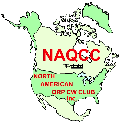
 | NAQCC News |
| September 13, 2008 | NAQCC Web Site | Issue #078 | |
|---|---|---|---|
| In this issue: 1. September Sprint 2. August Challenge Results 3. Operating Tips 4. General Club News 4a. N3A Update 5. CW Cartoon of the Month 6. Member News |
| 1. SPRINT: Our sprint is this Wednesday evening, September 17th at 8:30-10:30 PM EDT (Thursday 0030-0230Z). This month's special award: The one making the highest score in each of our 5 divisions and having all ten digits (0-9) somewhere in the member numbers in their log qualifies for the drawing to select our winner. There are also the other usual prizes and certificates topped off by our monthly giveaway of a CW book on CD donated by Chuck K7QO. Chuck is currently giving away one CD to the high scorer who hasn't won a CD before. As with the special award, the CD is awarded in a drawing among the top qualifiers from each of our sprint divisions. There is now a list of all the current CD's available in the General Sprint Rules. Club officers are not eligible for the CD's. Our autologger has speeded up reporting of results so much we have now changed our log submission deadline. Remember the deadline is now 2400Z on the Sunday following the sprint. The log must be RECEIVED by that time. We may make allowances for regular mail entries if they have been postmarked early enough but may have been delayed in the mail system. If you're entering one of our sprints for the first time, we welcome you and hope you will be a regular participant from now on. Remember our sprints are NOT the normal fast paced hectic events that come to mind when sprints are mentioned. Ours are designed for the newcomers to contesting with a relaxed slower pace style - ideal for learning the fun art of ham radio contesting. Remember this is only a brief overview of the coming sprint. Be sure to always read and understand the full general sprint rules and any specific rules for the current month's sprint. Complete sprint results and rules always can be found here. 2. AUGUST CHALLENGE RESULTS: As with all our alphabet challenges, this one was very popular as well. If you have any doubts about whether you would like to try one of our challenges, please read the soapbox comments in the results for this challenge. I think that will convince you just how enjoyable an experience they are and also how they help teach CW skills as well. In particular pay close attention to N9AKF's soapbox entry. We had ten entries for the challenge. Of those, K3WWP and NU7T tied for the most number of different calls used to complete the challenge with the maximum of 75. However K3WWP decided to forego his certificate and let the next person in line have it. That was K4PBY who used 72 calls. We had two drawings in conjunction with this challenge. One for the bug/paddle handles as usual and a special drawing for the ham radio cartoon book donated by Paul N8XMS. The winner of the cartoon book drawing was Steve NU7T The winner of the bug/paddle handles drawing was K4PBY Certificates went to NU7T and K4PBY for using 75 and 72 calls respectively Full challenge info and final results including my tutorial/work sheet for our alphabet style challenges here. 3. OPERATING TIPS: A lot of members joined the club because they wanted to improve their CW skills and increase their speed. Ron K5DUZ and Karl N3IJR have some very good ideas along those lines and I'm looking forward to what they have to say when they get the Elmer project for the club going. Ron tells me they are very close now to a debut. I hope so, but in the meantime I'll offer my brief thoughts on the matter. For the rank newcomer to CW, the current best way to learn the code is via a computer program which has replaced the classic CW practice tapes method. Those old tapes were great, but a computer program is more flexible. You could get to the point where you memorized the content of the tapes. Not so with a computer program that can generate random characters or words using all letters and/or numbers or just a few select letters/numbers at a time. Or you can point the program to any text file and have it send code from that at any speed you choose, regular or Farnsworth method. My favorite of all the programs I've tried, although by the time the computer programs became popular, I no longer needed them, is one called simply and to the point "Just Learn Morse Code" available FREE here. There is virtually no limit to the ways it can be used to send Morse Code. I'd suggest giving it a try to see what I mean. Once you do become competent enough with the code to get on the air, our NAQCC has two great ways to get some actual practice. One is our monthly sprints. They are geared to the beginner with most ops who enter very willing to slow down and keep things at a leisurely pace. It's great practice copying code under 'battlefield' conditions, so to speak. Then for ordinary, not contest, style operating practice, there are our monthly challenges. I hope that tides you over till Ron and Karl get going with the Elmer project. More tips can be found on the web site here. 4. GENERAL CLUB NEWS: - We have a ton of news this month, and I hope I don't forget to include any of it. Of course, our anniversary special event operation next month is the big news. It's hard to believe the club has been around for 4 years now and we'll be going into our fifth year. Time indeed does fly when you're having fun, and the club has been a ton of fun for all of us. Our sprint has grown from about 4 or 5 participants to now having around 60 logs submitted for each sprint. We are now one of the biggest QRP/CW sprints around, thanks to YOU! More could be said about the growth of the club, but we'll save that for the two newsletters during our actual anniversary month of October. We now have N3A ops from all 10 call areas, but you are still welcome to come aboard. We may need additional ops to ensure we have all 10 call areas active in both the FISTS sprint and our NAQCC sprint if those already signed up have other commitments on one or both of those days. See the special N3A section below for more info. In addition to that, Fred KC8FS will be doing our certificate printing and mailing starting with the certificates for the August challenge. That is another big help. It's great to see our members starting to come forward to help out with the running of the club. We also have a new giveaway and a couple new awards coming up to start our 5th year. We don't want to overload you with info in this, our largest newsletter to date, so we'll hold off on those announcements till a later newsletter. 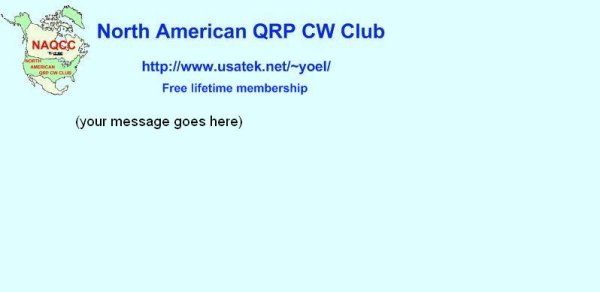 4a. N3A UPDATE: - Thanks to those who have signed up to be N3A ops so far. Our special event call has now been approved and we're ready to go from 0000Z Oct. 1st through 2400Z Oct. 31st. We now have ops from all call areas. However that doesn't mean you can no longer volunteer to help out. We want to have ops from all 10 areas in both the FISTS Fall Sprint and our own NAQCC Sprint in October. Perhaps you are interested in only doing one of those sprints, and if someone already signed up from your area is not a contester or has other obligations those days, you could just operate one or perhaps both of those events. Also obviously the ones already signed up are not going to be operating 24/7 so there's plenty of time available for you throughout the whole month. So join up. We're sure you'll enjoy it. Here's who we have as ops so far: N3A/1 - W1OH (MA), K1YAN (MA) N3A/2 - N2JNZ (NY), W9VES (NJ) N3A/3 - WY3H (PA), K3WWP (PA), AF3Z (PA), AE3J (DE), KC2EGL (PA) N3A/4 - K4UK (VA), KB4QQJ (NC) N3A/5 - W5TM (OK), AE5BH (TX) N3A/6 - K6BBQ (CA) N3A/7 - KH6OZ (MT), WY7N (UT) N3A/8 - WB8LZG (MI) N3A/9 - K9JWI (IN), AI4AW (WI) N3A/0 - AB0TX (KS) We're still hoping for more ops from last year to sign up this year, but it doesn't look like that is going to happen. Still even if they don't sign up this year, we appreciate the great job they did last year and will always be grateful for their help in making our 2007 celebration such a fantastic success. I just started sending out email guidelines for operating N3A to all our ops. Updates will be emailed as things come up. Also watch this section of the newsletter and the N3A page on the web site for additional information. One thing I mentioned in the guidelines was an alplabetized by call sign list of members. In case anyone doesn't know, it's available for download via the memberlist section of the web site. It's updated near the end of each month. Just read the info at the top of that page. As I sit here and type this, I'm really getting excited about our October celebration. It will be great to be using N3A/3 again after 11 months. Maybe I can win another certificate for the club in the Pennsyvania QSO Party. 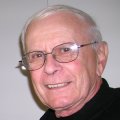 5. CW CARTOON OF THE MONTH: Let's take a comedy break now courtesy of Dick Sylvan W9CBT. Dick has been a long-time QRP/CW operator. One of his many talents is being a cartoon artist, and he is supplying a cartoon each month for the newsletter. The NAQCC is very honored to be one of just two organizations to feature Dick's cartoons. In addition to our newsletter, Dick's cartoons appear monthly in The K9YA Telegraph, an on-line only Ham Radio E-zine where he is the staff cartoonist. Dick has also authored a book entitled "Hi Hi - A Collection of Ham Radio Cartoons" available via his web site. A new cartoon will be appearing in each of our even-numbered newsletters. 5. CW CARTOON OF THE MONTH: Let's take a comedy break now courtesy of Dick Sylvan W9CBT. Dick has been a long-time QRP/CW operator. One of his many talents is being a cartoon artist, and he is supplying a cartoon each month for the newsletter. The NAQCC is very honored to be one of just two organizations to feature Dick's cartoons. In addition to our newsletter, Dick's cartoons appear monthly in The K9YA Telegraph, an on-line only Ham Radio E-zine where he is the staff cartoonist. Dick has also authored a book entitled "Hi Hi - A Collection of Ham Radio Cartoons" available via his web site. A new cartoon will be appearing in each of our even-numbered newsletters.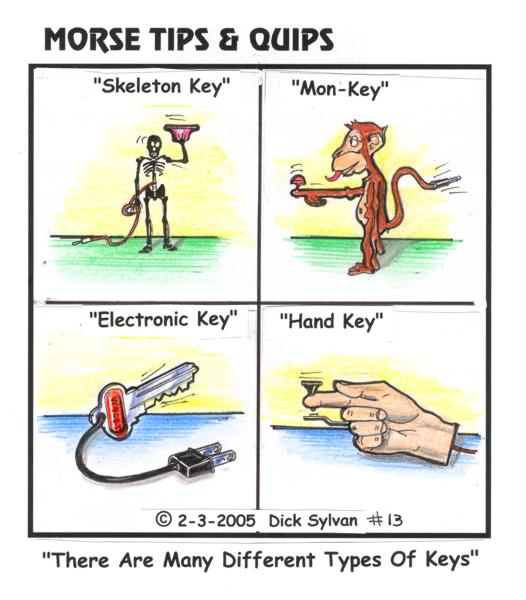 6. MEMBER NEWS: Send your news items to our news editor Paul KD2MX at A few years had passed and all of a sudden it was time for graduation from high school. Fresh out of school I decided to enlist in the US Army. With a interest in radio still burning inside me I decided to go into the Signal Corps. In September of 1981 I left for basic training and advanced individual training. Basic was scheduled to take place at Fort Jackson, (Columbia) SC. It was changed to Fort Gordon, (Augusta) Ga. I finished basic training in November and within a week I started my journey into HF radio operations. I began training as a Radio Teletype Operator. This was a HF system. The setup was in a shelter mounted on the back of a pick-up truck. It consisted of a AN/GRC 106 (a two piece radio consisting of a R/T and a Amp/Antenna Tuner), TT-98 (Teletypewriter with three row's of key's) TT-76 (Ticker tape Punch Teletype, punched out messages on a ticker tape), MD-522 (modem, very primitive next to today's modem's), KW-K7(cryptographic device), either a 5 element 15' whip antenna or a dipole cut to the frequency being used. All of this was connected to a AC to DC power supply when powered up with a 5KW generator or direct DC when the vehicle engine was used. Over a eight year period (six of which were on active duty) I was stationed in Germany, Georgia, Korea, and back to Georgia. It was the second visit to Georgia that guided me to Amateur Radio. While stationed at Fort Stewart (Hinesville) Ga. I met John Cleveland (then KF3U, now KF3Q) who is a Ham and also my crew mate. Since Amateur Radio and Radio Teletype used the same set up it was very easy to become interested in Amateur Radio. I started with the Tune In The World study guide from the ARRL. I was moving along rather well when all of a sudden I met a lady. This meeting put off my attempt at getting my license for a while. The time with the lady (ironically she was also in the same job as I was) fizzled out. By this time my friend and crew mate had left the Army and headed out west to California. I soon left the Army as well in July of 1989. On my return home to New York City I continued with the study guide. Unfortunately I did not know anyone else who was a Ham. And this being before the Internet was available to the masses put me in a position to put off getting my license. During December of 1996 I found myself with a brand new Toshiba Infinity (Toshiba's answer to the IBM machine of the time) and a connection to the Internet at a blazing speed of 14K. It took me a year before searching for the ARRL via the web. Then it happened again. I met another lady. Well this adventure did not pan out as well. Shortly after it ended I decided to put my nose to the grindstone and get my license. I searched for exam sites and found one being held during the Fall ham fest of the Great South Bay ARC. I hopped on the LIRR (Long Island Rail Road) and headed out to the Babylon Town Hall in North Lindenhurst, NY (don't ask me why the Babylon Town Hall is in North Lindenhurst. I have yet to figure it out myself.) I took the Novice and Tech No-Code written exam and passed. Soon after I purchased my first radio. A ICOM TA-8A triband hand-held (6M, 2M, 70CM). I also joined the Great South Bay ARC. Since I lived in a third floor apartment I was not able to have a HF set up. So I put off upgrading my license. Then in 2000 the FCC (just took a break to have a QSO with Mark AB7MP) decided to dumb down the CW requirement to 5WPM for all license classes that required CW. I decided that even though I can not have a HF set up in my apartment I would go for the upgrade to General and pass my 5WPM CW. I passed my CW exam just so I could get my General license. I wanted to be able to operate (if the opportunity arose) on better frequencies. I soon purchased a Kenwood TS 570 and a Astron power supply just in case I could find a way to set up a station. I continued to work 2M/70CM with the occasional visit to my club's station for some HF fun. And yes during this time of final preparation and passing of my exam's for my license I met yet another lady. The only difference is that this time it worked. In July of 2001 I moved from New York City to Hawthorn Pa to be closer to this gal. Fortunately for me my line of work permits me to transfer anywhere there is a opening in my job field. I deliver mail for a living. My job transferred me to Kittanning Pa. I felt living in Hawthorn would be the best bet at first because it was roughly half way between Kittanning and Brookville Pa where I wanted to work and live all along. I rented a house in Hawthorn with a nice sized yard with a line of pine tree's along the side of the road. I tossed a Alpha-Delta DXCC 10-80M dipole and got on the air and started having a blast with HF. I soon found myself a new club to join in Kittanning. The Fort Armstrong Wireless Association (FAWA). One day while delivering mail I found a QSL card addressed to a character named John Shannon K3WWP. When I arrived at his house I knocked on the door and introduced myself. I told him of what I did with Amateur Radio. None of which was CW related. I had forgotten all that I had learned because I did not use it. He immediately began the CW brainwashing. During this time of brainwashing (which I was not aware of) I had transferred once again. This time to Brookville Pa. A year later I moved to Brookville as well. I have a nice line of tree's in the back yard. The Alpha Delta DXCC has been replaced with a Cobra Ultra-lite Senior folded dipole (10-160M also tunes up on 6M with a external tuner). All the time I kept in touch with John K3WWP. And yes he continued the brainwashing from a distance via email and his wonderful website. One day while reading the forum's on QRZ.com I came across a posting advertising the formation of a new CW club that promotes straight key use (some of you fine people know of this club, SKCC). I joined and received number 553. And I still did not have a clue about operating CW. That is when I turned to John and asked if he could recommend a training program for CW. He directed me to www.justlearnmorsecode.com. I would practice four to five times a day at fifteen minutes a session. By the end of the year (2006) I was able to copy 5WPM with said program. During January of 2007 SKCC celebrated it's first anniversary. I volunteered as the W3 coordinator with ZERO CW experience. I had a few on air practice sessions with Kevin K4VD, but no real time operating CW. I organized the schedule for any operator's interested in operatine K1Y/3 for the month of January. Unfortunately I was the only one who showed any interest for the first three weeks of the month long event. My first week on the air I would put in two hour time slot's operating K1Y/3. I was lucky if I could fit in five QSO's a hour. Being a very green rookie and very nervous, I was rather slow. But as time passed my speed picked up. I remember my very first NAQCC sprint. I operated as K1Y/3. If memory serves me correctly I think I had maybe 6 QSO's. From that month on with the exception of checking into my club's weekly 2M ARES/RACES net as well with the occasional WPA Phone and Traffic net (which I have not checked into in since June of 2007 and only four times since I started CW) I have operated CW exclusively. And to add to the thrill of it all I have operated QRP exclusively since January 16, 2008. And in April of this year I purchased a new radio. A Elecraft K-2. It is by far the best radio I have ever operated. Most of my radio operating is of military type radios. I have operated a few Amateur specifc radios since. None can keep up with the K-2. I now use my TS 570 as a back up. During all this time living in Brookville I did purchase a TS 480 SAT which has resided at the QTH of John K3WWP ever since I got my K-2. So there it is in a nutshell. My life in radio. On November 5 of this year I will have been a Amateur Radio Operator for ten years. The best thing about Amateur Radio is that the fun just gets better and better each and every time I fire up my rig. Here is a picture of me operating in a park on the shore of Lake Michigan in Ludington, MI and a second picture of a beautiful sunset that we enjoyed about an hour later. 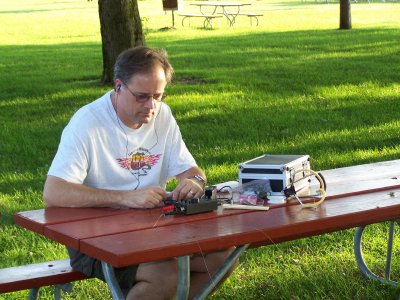 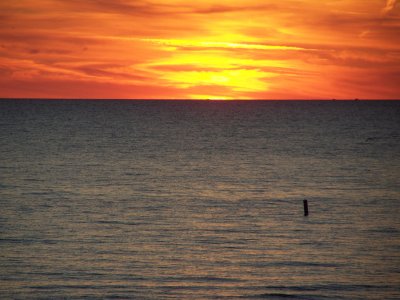 By 18:00 UTC we were on the air making contacts. We filled up three log sheets, half on CW and the rest on phone. Robin N3CJM provided lunch and snacks as usual. It was great. Steve, K3MOT, a new ham operated phone on 20 meters making a great big pile up. I operated 20 and 40 CW working stateside and DX stations, all very happy to work Delaware and USA 568. The highpoint for me was when my son James KB3ROI made his first TWO WAY QRP CW DX contact with F8BBL. I am working with the two controlling agencies that have jurisdiction over Reedy Island to allow an overnight radio expedition some time in the spring of 2009. We have a large group of hams that think field day should be all year long so we get out at least once a month to operate portable from the banks of the Delaware River and Bay. We go marine mobile from one of our boats or air mobile from the plane. So get out there and make radio fun!!!!!!! On the drawing board before it gets too cold is a canoe trip on the Brandywine River QRP canoe mobile. And a trip to the Appalachian Trail at Lehigh Gorge from the top of Blue Mountain. I know of a four wheel drive trail that will get us to the summit with all our gear. When the hikers come along and see us with a 4x4 and base camp with electric and satellite TV they are amazed and think we are nuts. No ma'am, we are just hams on a mission to have fun. Particpants included Bill, AE3J, James K3ROI (ex KB3ROI) #516, Bill Jr (SOON to be licensed) #515, Steve K3MOT, and Robin N3CJM #462 James, K3ROI, working F8BBL on 20CW 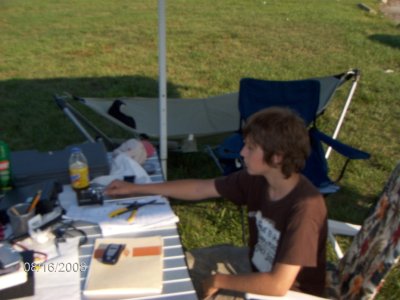 The kite antenna 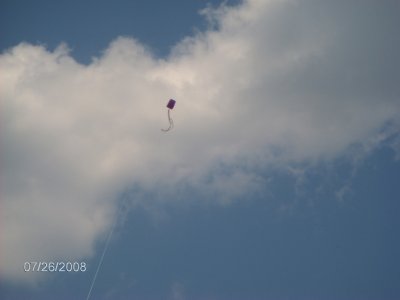 James, K3ROI, with vertical antenna and nuke plant in background 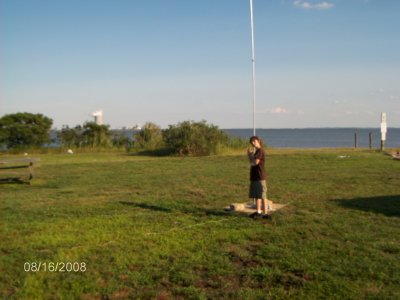 K3ROI and Bill, AE3J installing the vertical 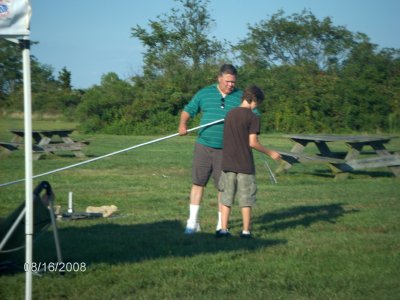 After an evening or two, all was soldered. I cleaned the boards by soaking in denatured alcohol for a half hour or so, then scrubbed a bit with an old toothbrush. I then followed the calibration procedure. All checked out OK. This was back in July. I didn't get on the air with it right away. I still had to drill holes in the tin, etc. That required another week or two. (I'm WAY too busy!) When all was tidy in the tin, no RX audio! That had me stumped for several weeks because I assumed that the calibration tone was OK during LO trim. (It worked before!) That caused me to look in the wrong area for the problem. It ends up that I had two problems. C41 was open and the 4.9152 MHz BFO oscillator wasn't running. The latter was due to flux under the crystal. Evidently the residue provided just enough conductance to swamp out the oscillator. I cleaned the residue off with some acetone. Now finally the rig is up!!! Note: Instead of using the solder that came with the kit I used whatever was laying around on the bench. I think the stuff I used has some pretty aggressive water soluble flux. The residue might have contained oxidation from the crystal can. The experience was frustrating, but it forced me to understand the circuit theory. The reward: The rig's maiden voyage was the last quarter of the NA CW Sprint. I worked thirteen different states throughout the country in about an hour using a random wire ~100' long and ~23' high, strung between a telephone pole and one corner of my house. Too bad the ATS-3B didn't come right up. I could have used it backpacking. My son and I have backpacked nearly 80 miles this summer, including 56 miles of the Highline Trail in the Wilderness Area of the Unitah Mountains and a rim-river-rim hike of the Grand Canyon. I have about as modest a set as possible, here in the middle of town. I use an indoor mounted antenna here, because of antenna restrictions, and get an amusing "spike" towards the Northeast into Canada. I'm not of the air as much as John, but find his observations to be true, and yes, I am confused as to why more people don't operate QRP, especially outdoors. I also can make a contact with my QRP just about every day! I made my 100th contact for this year a few days ago and here's the story of how I did it. This morning I worked KI4RNY in Alabama. This was my second contact with him, on the same frequency and almost the same time as a week earlier. This time, the signal was a little weaker (229 at best) and band conditions were very, very, poor! The band was just horrible, and we both had difficulty exchanging the basics, but we sent and received our Calls, Names, and QTH's. Not much more......QSB and QRN were discouraging. Bill was number 100 in my 2008 log book! I had hoped for a QRP contact and CQ'd several times earlier on the 40 meter calling frequency. But when sending CQ a little further up the band, there were several signals responding in the noise, and Bill was the "first" I thought I could copy and exchange the "basics" for a contact. I've been retired for four years now and this has been my most enjoyable year for ham radio. I'm very comfortable with using my "straight key" QRP rig now. I'll keep the microphone nearby and the Iambic Paddles in the drawer, but only anticipate using them for "special events" or faster CW contests. I really like the slower CW with "character" that is only possible when using a "Straight Key". It's unique! On another note: I've also been making "unusual" contacts into the Northeast with my ICOM 703 and my indoor mounted "Isotron Antenna". I'm getting 579-599 reports near the "1000 Mile Range" with QRP power! 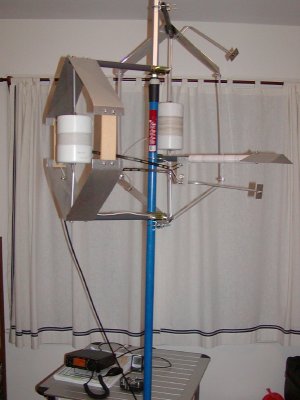 I seem to have "a distinctive pipeline" into the Northeast from Charleston WV. (I know this by plotting the locations with a mapping program I have on my PC). I made another one of those "pipeline" contacts to the Northeast a few days ago. Marcy NY (KD2MX) is on a direct line with both Burlington Vermont, and Sherbrooke Canada (VE2PID) and there's actually a second "pipeline" when I consider a contact to (VE1BA-qrp) Kingston, Nova Scotia. (Most of my good '579-599'reports are along this narrow line towards Canada). It's a very narrow path and I've searched for an answer, for several months, because my antenna should radiate omni directionally, but I'm getting a sharp "spike" out of the valley, where my elevation is 600 feet above sea level. I've made 13 Canadian contacts the last few years, of which 3 have been QRP contacts. One (VE3CGC) was using 3 watts. I think I've got an explanation now.....I've got an eight story apartment building next door that is about 150 feet from me. It's positioned "just right angle" to bounce a signal up that way. (Hey...it's the only explanation that I can come up with). I've been jokingly telling people, the last few months, that I get an incredible bounce off the "real gold" covering the dome of the State Capitol, just up the street from me. I like the "Gold Dome of the Capitol Building" explanation much better, and it's a better conversation piece, but it's becoming more of a "stretch" every day now. (I haven't sold it to anyone yet).  I'm amazed at the QRP contacts I've made this year, with "poor" propagation, and a solar flux mostly in the 60's. I use an "indoor mounted Isotron antenna" for the majority of my contacts. My home, in a "historic district" in Charleston, doesn't encourage outdoor wires or antennas. I've worked 10 DX stations this year, (most with a little 18" 20 meter Isotron antenna) and 25 of those 100 stations, I've worked so far this year, have been using 5 watts or less.... Of those 25 QRP stations, 3 were QRPp. (all on 40 meters). I worked those QRPp stations while using one watt. |
| The publication of our next newsletter will be announced via email to all members for whom we have a valid email address unless they specifically have unsubscribed from the email. Unless otherwise credited, all items are written by K3WWP. If you came directly to this newsletter, we invite you now to browse the NAQCC Web Site. |